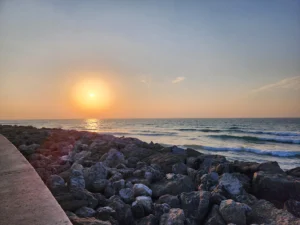
About Old Umm Al Quwain
Description
As someone who’s explored countless historical sites across the UAE, I gotta tell you – Old Umm Al Quwain hits different. This former fishing village turned heritage site offers a raw, unpolished glimpse into the Emirates’ past that you just won’t find in the glitzier parts of the country. Y’know what I love most about it? The fact that it hasn’t been overly commercialized like some other historical spots.
The old fort, which now houses the local museum, stands as the crown jewel of this atmospheric place. I remember the first time I walked through its sturdy walls – the sense of history just washes over you. The exhibits inside tell fascinating stories about pearl diving, maritime trade, and the everyday lives of people who called this place home centuries ago.
What really gets me excited about Old UAQ (that’s what us locals call it) is how it maintains its authenticity. The narrow sikkas (alleyways) wind between traditional coral stone houses, and if you’re anything like me, you’ll find yourself constantly stopping to admire the intricate architectural details that have somehow survived the test of time.
Key Features
• The historic fort-turned-museum with its impressive collection of archaeological findings
• Traditional coral stone houses showcasing authentic Emirati architecture
• Ancient watchtowers that once protected the settlement
• The old dhow harbor where wooden boats still bob in the water
• Historic marketplace (souq) area with remnants of old trading posts
• Archaeological sites revealing artifacts from different historical periods
• Traditional wind towers (barjeel) demonstrating early cooling systems
• Restored mosque with classic Islamic architectural elements
Best Time to Visit
Listen, I learned this the hard way – timing is everything when visiting Old Umm Al Quwain. The sweet spot is between November and March, when the weather’s actually bearable (trust me on this one!). During these months, temperatures hover around 20-25°C (68-77°F), making it perfect for exploring the outdoor sites without melting into a puddle.
Early mornings or late afternoons work best for photography – the light hits those old coral walls just right, creating some seriously Instagram-worthy shots. And here’s a pro tip from someone who’s been there way too many times: Friday mornings are surprisingly quiet, as most locals are at prayers.
Avoid summer months (June-September) if you can help it. The heat can be brutal, and honestly, it’s hard to appreciate historical architecture when you’re basically cooking under the sun.
How to Get There
Getting to Old Umm Al Quwain isn’t exactly rocket science, but it does require some planning. From Dubai, you’re looking at about a 1-hour drive up the E11 highway (Sheikh Zayed Road). I usually take this route because it’s straightforward and well-signposted.
If you’re coming from Sharjah, it’s even easier – just a 45-minute drive. Public transport options are limited (welcome to the UAE!), so your best bet is either driving yourself or catching a taxi. Ride-hailing apps work here too, but keep in mind you might need to book your return journey in advance.
For those without wheels, there are some tour companies operating from Dubai and Sharjah that include Old UAQ in their heritage tours. Though personally, I prefer the freedom of having my own car to explore at my own pace.
Tips for Visiting
Alright, let me share some real talk based on my countless visits. First off, bring a water bottle – there aren’t many shops around and the UAE sun is no joke. I always pack some snacks too, because food options can be limited in the old town area.
Dress respectfully – this is still a conservative area. I typically go with loose, comfortable clothing that covers shoulders and knees. Ladies, a light scarf can come in handy if you’re planning to visit any religious sites.
Photography is generally allowed, but be mindful of local residents – some buildings are still inhabited. I’ve found that asking permission before taking photos of people or private properties goes a long way in maintaining good vibes.
The museum inside the fort sometimes has irregular opening hours (been caught out by this myself a few times). It’s worth calling ahead to check if you’re making a special trip for it. Most explanatory signs are in Arabic and English, but having a guide can really bring the place to life – they often share fascinating stories that aren’t written in any guidebook.
And here’s something I wish someone had told me on my first visit: wear comfortable shoes! The ground can be uneven, and there’s quite a bit of walking involved if you want to explore properly. Those stylish sandals might look cute, but trust me, your feet will thank you for choosing comfort over fashion.
Oh, and one last thing – carry cash. While some larger establishments might accept cards, many smaller places don’t. Plus, you might want to pick up some traditional crafts from local artisans who definitely prefer good old-fashioned currency.


